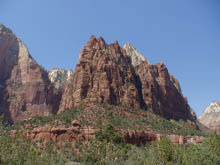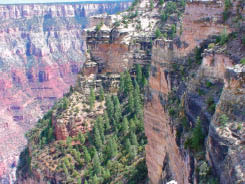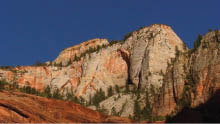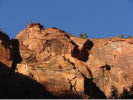
 There are many things that young
people encounter at school and at church that can cause doubts to
arise. It is difficult to travel anywhere and not see layers of
rocks which have different colors, textures, and structure. Church
leaders may blow off these layers as “God’s creation” without any
consideration of why there should be different rocks in separate
layers at all. “God just did it that way” may satisfy some minds,
but most young people will want to go further. Why do some rocks
have holes in them and some have fossils in them? Why are there
beautiful crystals in some rocks and why do others have bands of
different minerals? When young people get evasive answers in Bible
class, or no answers at all from church leaders there is a tendency
to wonder why. One recent e-mail from a young lady said it well, “It
just seems like they are afraid of the message that the rocks
contain and want to avoid discussing why these things exist.”
There are many things that young
people encounter at school and at church that can cause doubts to
arise. It is difficult to travel anywhere and not see layers of
rocks which have different colors, textures, and structure. Church
leaders may blow off these layers as “God’s creation” without any
consideration of why there should be different rocks in separate
layers at all. “God just did it that way” may satisfy some minds,
but most young people will want to go further. Why do some rocks
have holes in them and some have fossils in them? Why are there
beautiful crystals in some rocks and why do others have bands of
different minerals? When young people get evasive answers in Bible
class, or no answers at all from church leaders there is a tendency
to wonder why. One recent e-mail from a young lady said it well, “It
just seems like they are afraid of the message that the rocks
contain and want to avoid discussing why these things exist.”
My first reaction to this issue is to say to young people that the
Bible does not take that position. The psalmist in Psalm 19:1 not only says that “The
heavens declare the glory of God” but also says that “the skies
proclaim the work of his hands.” We can look throughout the natural
world that surrounds us on earth and see God’s wisdom and design. In
Proverbs 8:23 – 27 we are told
that wisdom was involved in the formation of the mountains, the
hills, the fields, and the dust of the world. In Romans 1:19, 20 we read “that which
may be known of God … from the creation of the world are clearly
seen, being understood by the things that are made, … so that [men]
are without excuse.” All of us need to understand that God has
created the earth with intelligence and purpose, and rocks are a
part of God’s creation. When we learn to read the rock record we
will learn just as we learn when we read His word.
ROCKS SHOW GOD’S PROVISION FOR MAN.
Many people do not understand that almost everything we have which
sustains our modern way of life comes from rocks — but not just any
rocks. Coal is produced from a very different kind of rock than the
rock that produces copper, gold, and silver. Gypsum, rock salt, and
limestone are very different from rocks which produce coal or oil.
These are still different from rocks which produce iron, aluminum,
and precious metals.

Even resources that are not produced within a rock itself are
frequently contained and stored for man’s use in rock containers. A
classic example is oil. Oil is produced by a microorganism called a
diatom, which forms a drop of oil in its body during its life. When
the microorganism dies it settles to the floor of the ocean and is
buried. As sediment piles upon it, the pressure squeezes the oil out
of the skeleton leaving diatomaceous earth. If the oil is in a
porous rock material like sand it will move into and through the
porous material. Some rock layers are not permeable and will not
allow the oil to migrate through them. Materials like shale (which
is lithified mud), will stop the oil and the oil will pool where it
hits the impermeable material. If the oil is deep within the earth
the oil will be heated by the heat generated from the earth’s core
and may be under considerable pressure. This oversimplified and
idealized picture is typical of a large number of important minerals
including natural gas, sulfur, and even water. Geologists locate
mineral resources and mine them by knowing the design of the
deposit, and understanding how it was produced.
The recent disaster in the Gulf of Mexico should raise some issues
for those who are interested in God’s methods. How did scientists
for British Petroleum know there was oil that far out in the ocean
and at that depth? We have learned how God has produced and
contained these resources in a natural way. If God “zapped” these
resources on the earth in some way, we would never be able to find
them. Whether we have tried to tap some resources like the ones in
the Gulf prematurely is certainly an issue that needs to be
addressed, but the fact that God has provided such resources in
natural ways is important for us to understand. It is a
demonstration of God’s wisdom and planning in providing resources in
a way that we can find and use them.
ROCKS HELP US UNDERSTAND EVENTS IN THE
BIBLE.
If the Bible tells us that a certain event was a miracle, we do not
try to explain it naturally — although atheists will certainly do
that. A miracle by definition cannot have a natural explanation.
What is interesting about the Bible is that there are very few
miracles in proportion to the size of the book and the number of
years that it covers. We tend to focus on things like the
resurrection and the virgin birth which clearly are miracles and are
presented as such, but many biblical events are not presented as
miracles and are understandable from scientific information.
 How could a small, young man sling a
rock that could kill a full grown warrior in full armor? I used to
do a demonstration with my physics classes using a centrifugal force
sling to show them how a small rock can have tremendous force,
certainly enough with the right composition and shape, to do what
the Bible describes in the account of David and Goliath.
How could a small, young man sling a
rock that could kill a full grown warrior in full armor? I used to
do a demonstration with my physics classes using a centrifugal force
sling to show them how a small rock can have tremendous force,
certainly enough with the right composition and shape, to do what
the Bible describes in the account of David and Goliath.
As agriculture has advanced and our knowledge of genetics has grown,
we have learned how to bring about chosen characteristics in
livestock. What Jacob did with Laban’s flocks in Genesis 30:31– 42 is practiced by
modern animal husbandry. The use of sexual stimulants and the
segregation of chosen genetic criteria are not alien to our modern
scientific understandings. The description in Genesis is not
specific, but natural techniques are involved, not a miraculous
zapping of chosen physical characteristics.
Those who deny that such understandings can be used to comprehend
the Bible message frequently are confused by their own assumptions.
Some assume that somehow the rods/branches in this last example were
the cause of the markings on the cattle. The Bible tells us the rods
were made so the white appeared and they were set near the watering
areas to stimulate conception, not that they caused the markings.
You can debate what stimulation was going on, but it was a natural
process, not a miraculous one.
Even the Flood of Noah has a description that involves natural
processes. The two sources of water given are “the fountains of the
deep” and the “windows of the heaven” (Genesis
7:11). Not only are these two sources given, but the duration
of rain is given. Critics of the Bible have made assumptions about
the condition of the earth at that time, when this happened, and
what the condition of the waters were. Were the mountains the same
height as they are today? Were the waters level (almost certainly
not)? What effect, if any, did this have on the planet and its land
masses as a whole? A myriad of other questions are unknown and yet
would have a profound effect on what took place naturally on the
earth during this event. The rocks tell us what could have been
Flood-caused and therefore part of this event. They also tell us
what would not have been caused by the Flood. Attempts to explain
the formation of the Grand Canyon by the Flood and comparing it to
what happened at Mount Saint Helens are easily dispelled by any high
school student who has had a course in earth science. The rock
record helps us know what is true and what is not true in human
theories and explanations.
ROCKS SHOW THE EARTH’S HISTORY AND
VERIFY THE WRITTEN WORD.
The Bible writers used an economy of language in what they wrote.
Their focus and their purpose was not to reveal science or history.
They were to show man’s relationship to God, how man breached that
relationship, and how God has provided a way for man to be restored
to that relationship. When we try to use the Bible for some other
purpose than that, we are going to run into problems. The main
problem with the history of the earth as recorded in the Bible is
its brevity. The simple statement “In the beginning God created the
heaven and the earth” is undated and untimed and covers the whole
history and substance of cosmology. No methodology is given and
massive amounts of the details are omitted.
 In spite of all of this brevity and economy of
language, what is stated is accurate. The sequence of the creation
process given in the Bible is exactly what we see recorded in the
rock record. That sequence is repeated even today when fire or other
catastrophic causes may reduce the surface of the earth to a
lifeless condition. Notice, for example, that a number of changes
are indicated in the earth itself before any kind of life is
discussed. To have any kind of life there must be the right
atmospheric conditions and soil with all of the nutrients necessary
for life has to be present. You cannot have just water, but you must
have land for life to exist. Marine life with all of its cycles and
sequences has to be the basis of life on the land. To have birds you
must have a food chain upon which birds can feed, and higher forms
of mammalian life has to come later. Within the plants it is
necessary to have simple plants to provide a base for higher forms
of plant life. Angiosperms, the plants that we depend upon for food,
can only exist when there is a base for the plants to draw upon. All
of this has to be in place before man can survive on the planet.
This is a carefully arranged sequence. Today we call it “succession”
and it is exactly what we see in the biblical record. It was used by
God to prepare the earth for man. It was used in God’s preparation
for man and his animals which the creation week describes, and it is
still used by God and man today to take sterile places and make them
suitable for human life. Theologians and skeptics can attempt to
reduce the Genesis account to a magical display of God’s power.
While it is incomplete, it shows God’s wisdom and design in the
creation in a very accurate description of the sequence of creation
without concerning itself with the specific methods or timing.
In spite of all of this brevity and economy of
language, what is stated is accurate. The sequence of the creation
process given in the Bible is exactly what we see recorded in the
rock record. That sequence is repeated even today when fire or other
catastrophic causes may reduce the surface of the earth to a
lifeless condition. Notice, for example, that a number of changes
are indicated in the earth itself before any kind of life is
discussed. To have any kind of life there must be the right
atmospheric conditions and soil with all of the nutrients necessary
for life has to be present. You cannot have just water, but you must
have land for life to exist. Marine life with all of its cycles and
sequences has to be the basis of life on the land. To have birds you
must have a food chain upon which birds can feed, and higher forms
of mammalian life has to come later. Within the plants it is
necessary to have simple plants to provide a base for higher forms
of plant life. Angiosperms, the plants that we depend upon for food,
can only exist when there is a base for the plants to draw upon. All
of this has to be in place before man can survive on the planet.
This is a carefully arranged sequence. Today we call it “succession”
and it is exactly what we see in the biblical record. It was used by
God to prepare the earth for man. It was used in God’s preparation
for man and his animals which the creation week describes, and it is
still used by God and man today to take sterile places and make them
suitable for human life. Theologians and skeptics can attempt to
reduce the Genesis account to a magical display of God’s power.
While it is incomplete, it shows God’s wisdom and design in the
creation in a very accurate description of the sequence of creation
without concerning itself with the specific methods or timing.
 The rocks also have much to tell us
about man’s history on this planet. The only thing left of the
distant past of human habitation on earth are the rocks and stones
that ancient people used to shelter themselves from the elements and
to worship, as wells as trinkets, weapons, and tools to sustain
themselves in a difficult world. The whole field of archaeology is
based to a great extent on being able to read what rocks have to
say. The role of salt from the mineral halite is clear in the Bible
and in archaeological digs throughout the world. Copper has been an
important metal in man’s history dating back to ancient times. In
some religions sacred rocks have turned out to be meteorites — rocks
from outer space. Sulfur burns forming brimstone, another important
subject in the history of man’s past and an important part of
warfare in the distant past. Volcanic eruptions have sometimes
buried man’s cities and frozen a page in history. Pompeii is perhaps
the most famous, but many places in the world have had similar
events.
The rocks also have much to tell us
about man’s history on this planet. The only thing left of the
distant past of human habitation on earth are the rocks and stones
that ancient people used to shelter themselves from the elements and
to worship, as wells as trinkets, weapons, and tools to sustain
themselves in a difficult world. The whole field of archaeology is
based to a great extent on being able to read what rocks have to
say. The role of salt from the mineral halite is clear in the Bible
and in archaeological digs throughout the world. Copper has been an
important metal in man’s history dating back to ancient times. In
some religions sacred rocks have turned out to be meteorites — rocks
from outer space. Sulfur burns forming brimstone, another important
subject in the history of man’s past and an important part of
warfare in the distant past. Volcanic eruptions have sometimes
buried man’s cities and frozen a page in history. Pompeii is perhaps
the most famous, but many places in the world have had similar
events.
Knowing something about rocks and the message they have for us is
important to students of history, religion, and the Bible. The
stones cry out in many ways to people of all ages and backgrounds,
and it is important for us to listen.
To watch a video of John Clayton teaching “A Short Course in
Petrology” go to www.doesgodexist.tv/petrology.html
Back to Contents Does God Exist?,
NovDec11.


 There are many things that young
people encounter at school and at church that can cause doubts to
arise. It is difficult to travel anywhere and not see layers of
rocks which have different colors, textures, and structure. Church
leaders may blow off these layers as “God’s creation” without any
consideration of why there should be different rocks in separate
layers at all. “God just did it that way” may satisfy some minds,
but most young people will want to go further. Why do some rocks
have holes in them and some have fossils in them? Why are there
beautiful crystals in some rocks and why do others have bands of
different minerals? When young people get evasive answers in Bible
class, or no answers at all from church leaders there is a tendency
to wonder why. One recent e-mail from a young lady said it well, “It
just seems like they are afraid of the message that the rocks
contain and want to avoid discussing why these things exist.”
There are many things that young
people encounter at school and at church that can cause doubts to
arise. It is difficult to travel anywhere and not see layers of
rocks which have different colors, textures, and structure. Church
leaders may blow off these layers as “God’s creation” without any
consideration of why there should be different rocks in separate
layers at all. “God just did it that way” may satisfy some minds,
but most young people will want to go further. Why do some rocks
have holes in them and some have fossils in them? Why are there
beautiful crystals in some rocks and why do others have bands of
different minerals? When young people get evasive answers in Bible
class, or no answers at all from church leaders there is a tendency
to wonder why. One recent e-mail from a young lady said it well, “It
just seems like they are afraid of the message that the rocks
contain and want to avoid discussing why these things exist.”
 How could a small, young man sling a
rock that could kill a full grown warrior in full armor? I used to
do a demonstration with my physics classes using a centrifugal force
sling to show them how a small rock can have tremendous force,
certainly enough with the right composition and shape, to do what
the Bible describes in the account of David and Goliath.
How could a small, young man sling a
rock that could kill a full grown warrior in full armor? I used to
do a demonstration with my physics classes using a centrifugal force
sling to show them how a small rock can have tremendous force,
certainly enough with the right composition and shape, to do what
the Bible describes in the account of David and Goliath. In spite of all of this brevity and economy of
language, what is stated is accurate. The sequence of the creation
process given in the Bible is exactly what we see recorded in the
rock record. That sequence is repeated even today when fire or other
catastrophic causes may reduce the surface of the earth to a
lifeless condition. Notice, for example, that a number of changes
are indicated in the earth itself before any kind of life is
discussed. To have any kind of life there must be the right
atmospheric conditions and soil with all of the nutrients necessary
for life has to be present. You cannot have just water, but you must
have land for life to exist. Marine life with all of its cycles and
sequences has to be the basis of life on the land. To have birds you
must have a food chain upon which birds can feed, and higher forms
of mammalian life has to come later. Within the plants it is
necessary to have simple plants to provide a base for higher forms
of plant life. Angiosperms, the plants that we depend upon for food,
can only exist when there is a base for the plants to draw upon. All
of this has to be in place before man can survive on the planet.
This is a carefully arranged sequence. Today we call it “succession”
and it is exactly what we see in the biblical record. It was used by
God to prepare the earth for man. It was used in God’s preparation
for man and his animals which the creation week describes, and it is
still used by God and man today to take sterile places and make them
suitable for human life. Theologians and skeptics can attempt to
reduce the Genesis account to a magical display of God’s power.
While it is incomplete, it shows God’s wisdom and design in the
creation in a very accurate description of the sequence of creation
without concerning itself with the specific methods or timing.
In spite of all of this brevity and economy of
language, what is stated is accurate. The sequence of the creation
process given in the Bible is exactly what we see recorded in the
rock record. That sequence is repeated even today when fire or other
catastrophic causes may reduce the surface of the earth to a
lifeless condition. Notice, for example, that a number of changes
are indicated in the earth itself before any kind of life is
discussed. To have any kind of life there must be the right
atmospheric conditions and soil with all of the nutrients necessary
for life has to be present. You cannot have just water, but you must
have land for life to exist. Marine life with all of its cycles and
sequences has to be the basis of life on the land. To have birds you
must have a food chain upon which birds can feed, and higher forms
of mammalian life has to come later. Within the plants it is
necessary to have simple plants to provide a base for higher forms
of plant life. Angiosperms, the plants that we depend upon for food,
can only exist when there is a base for the plants to draw upon. All
of this has to be in place before man can survive on the planet.
This is a carefully arranged sequence. Today we call it “succession”
and it is exactly what we see in the biblical record. It was used by
God to prepare the earth for man. It was used in God’s preparation
for man and his animals which the creation week describes, and it is
still used by God and man today to take sterile places and make them
suitable for human life. Theologians and skeptics can attempt to
reduce the Genesis account to a magical display of God’s power.
While it is incomplete, it shows God’s wisdom and design in the
creation in a very accurate description of the sequence of creation
without concerning itself with the specific methods or timing. The rocks also have much to tell us
about man’s history on this planet. The only thing left of the
distant past of human habitation on earth are the rocks and stones
that ancient people used to shelter themselves from the elements and
to worship, as wells as trinkets, weapons, and tools to sustain
themselves in a difficult world. The whole field of archaeology is
based to a great extent on being able to read what rocks have to
say. The role of salt from the mineral halite is clear in the Bible
and in archaeological digs throughout the world. Copper has been an
important metal in man’s history dating back to ancient times. In
some religions sacred rocks have turned out to be meteorites — rocks
from outer space. Sulfur burns forming brimstone, another important
subject in the history of man’s past and an important part of
warfare in the distant past. Volcanic eruptions have sometimes
buried man’s cities and frozen a page in history. Pompeii is perhaps
the most famous, but many places in the world have had similar
events.
The rocks also have much to tell us
about man’s history on this planet. The only thing left of the
distant past of human habitation on earth are the rocks and stones
that ancient people used to shelter themselves from the elements and
to worship, as wells as trinkets, weapons, and tools to sustain
themselves in a difficult world. The whole field of archaeology is
based to a great extent on being able to read what rocks have to
say. The role of salt from the mineral halite is clear in the Bible
and in archaeological digs throughout the world. Copper has been an
important metal in man’s history dating back to ancient times. In
some religions sacred rocks have turned out to be meteorites — rocks
from outer space. Sulfur burns forming brimstone, another important
subject in the history of man’s past and an important part of
warfare in the distant past. Volcanic eruptions have sometimes
buried man’s cities and frozen a page in history. Pompeii is perhaps
the most famous, but many places in the world have had similar
events.